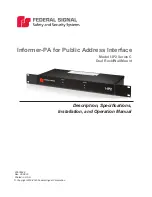
1
Rack-mounting bolt
7
Leveling foot
2
Thin washer
8
Lower plastic isolator bushing (used
only on dc-powered systems)
3
Top plastic isolator bushing
9
Stabilizer brackets
4
Thick washer
10
Threaded hole (used to secure the
rack to mounting plate.)
5
Spacer
11
Anchor bolt hole
6
Jam nut
12
Traced pattern (pattern to be traced
onto the floor using the mounting
plate as a template)
30.
Using your anchor bolts, secure the back stabilizer bracket on top of the raised floor and through to
the concrete floor.
31.
Replace all raised-floor panels that may have been removed when aligning and securing the anchor
bolts to the concrete floor.
32.
Align the rack over the front and rear stabilizer brackets.
33.
Insert each of the bolt assemblies through a leveling foot.
34.
Align the rack-mounting bolts with the threaded holes in each stabilizer bracket. Turn each bolt three
to four rotations.
35.
Tighten the locking screw on each caster.
36.
Adjust the leveling feet downward as needed until the rack is level. When the rack is level, tighten
the jam nuts against the base of the rack.
37.
If you have multiple racks that are connected as a suite (bolted to each other), go to “Connecting
multiple racks with rack-to-rack attachment kit” on page 33. Otherwise, torque the four bolts to 54 -
67 newton-meters (40 - 50 foot-pounds).
38.
If you are not installing doors on your rack, install the top, left, and right trim panel.
Figure 10. Securing the rack to the floor
12
Power Systems: Racks and rack features
Summary of Contents for 7014-T42
Page 1: ...Power Systems Racks and rack features ...
Page 2: ......
Page 3: ...Power Systems Racks and rack features ...
Page 6: ...iv Power Systems Racks and rack features ...
Page 72: ...60 Power Systems Racks and rack features ...
Page 73: ......
Page 74: ... Printed in USA ...
















































